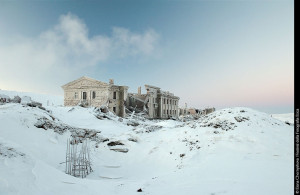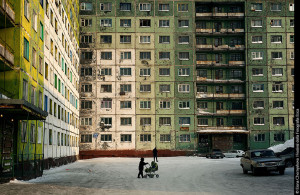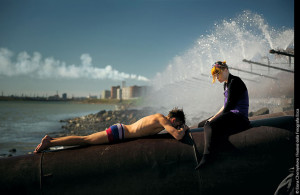Elena Chernyshova - Days of Night - Nights of Day
Norilsk, in northern Russia, is -after Murmansk- the second-largest city within the Arctic Circle, with a population of over 177,000.
Even nowadays Norilsk has no ground connection with the rest of the world: it can be reached only by plane and the seaway.
It is also one of the ten most polluted cities in the world. 2 million tons of gas rejected every year in the atmosphere; 100.000 ha of tundra in the radius of 30 km is dead; the life expectancy is 10 years less than in other regions of Russia. The risk of cancer is two times higher. Respiratory diseases are spread.
Rich metal and mineral deposits make the region a primary global source of such commodities as nickel, cobalt, platinum and palladium, and Norilsk maintains the biggest metallurgical and mining complex in the world. Almost 56% of the present population is involved in the industrial process.
Norilsk was founded in the 1935s, and until 1956 operated as a Soviet Gulag. During 20 years around 500 000 prisoners, from which thousands have lost their lives, labored there in the conditions of intense cold, starvation, and forced under construction of the mines and factories and the city itself.
Norilsk endures an extremely harsh climate, with temperatures dropping below -50°C in the winter, and rising into the high 20s or 30s in the brief summer months. The city is covered in snow for 250-270 days a year, has frequent violent snowstorms and experiences polar nights from November to mid-January, when the sun does not rise above the horizon.
The polar days and nights cycle has a strong influence on the physical and psychological conditions of the human body. The Norilsk’s citizens suffer ‘the polar night syndrome’, resulting in anxiety, nervousness, drowsiness or insomnia, depending of the seasons. The psychological discomfort and poor emotional stimuli also generate many cases of depression.
Norilsk is thus a living example of human adaptation to extreme conditions of climate, ecological disaster and isolation, living in autarky.
Text by Elena Chernyshova
Elena Chernyshova
 Elena Chernyshova is a Russian documentary photographer, based in France. She was born in 1981 in Moscow, USSR.
Elena Chernyshova is a Russian documentary photographer, based in France. She was born in 1981 in Moscow, USSR.
A self-taught photographer, she developed a passion for this visual language during her studies at an architectural academy. After two years of work as an architect, Elena quit her job and cycled with Gael de Cevoisier from Toulouse to Vladivostok and back again: 30,000 kilometres, 26 countries, 1,004 days of cultural, human, and challenging experiences. The trip led to her decision to become a photographer.
Photography for her is a way of investigating the daily life of different groups and communities in the context of environmental, political, and economic change. Her work aims at visualizing the impact of human activity, ways of adaptation, and diversity of lifestyles.
In 2011 Elena received a grant from the Lagardère Foundation to create the photo documentary ‘Days of Night – Nights of Day’ about the daily life of the industrial city of Norilsk, 400 kilometres to north of the arctic Circle in Siberia.
Elena’s work has been published in National Geographic, Geo, 6 Mois, Le Monde, Le Figaro, Neon, Internazionale, Days Japan, Courier International, Le Temps, Sunday Times, A/R magazine, Newsweek Russia.
She has received many awards, among them the FREELANCE Award 2016, Honorable mention; World Press Photo 2014, Daily Life, 3rd prize stories; Exchange prize and a Public prize at the Festival des Boutographies 2014; Days Japan International Photo Journalism Awards 2014 – Special Prize by the Jury; Finalist of « Invisible Photographer Asia Photos Essay Awards 2013 »; ‘coup de cœur of ANI’ 2010 (during the ‘Visa pour l’Image’ festival); ‘European Emerging Talent’ at the Nikon International Photo Contest 2008-2009.




